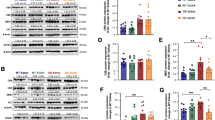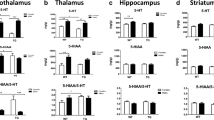Down syndrome (DS) is the most common genetic cause of significant cognitive disability. We hypothesize that by identifying metabolic alterations associated with cognitive impairment, it may be possible to develop medical or dietary interventions to ameliorate cognitive disabilities in persons with DS. Evidence suggests that one-carbon/transsulfuration (1C-TS) metabolism is abnormal in persons with DS. Cystathionine beta-synthase (CBS) plays a critical role in this metabolic system. The gene for CBS is on human chromosome 21, and there is evidence of elevated CBS enzyme activity in tissues and cells from individuals with DS. To analyze the possible role of CBS in Down syndrome, we have produced several lines of transgenic mice expressing the human CBS gene. We describe the use of Florescence Situ Hybridization (FISH) analysis to characterize the transgene insertion site for each line. Our initial expression analysis of each transgenic line by RT-PCR shows that the tissue specificity of human CBS mRNA levels in these mice may differ from the tissue specificity of mouse CBS mRNA levels in the same animals. These mice will be invaluable for assessing the regulation of the CBS gene and the role of CBS in cognition. They can also be used to develop therapies that target abnormalities in 1C-TS metabolism to improve cognition in persons with DS.



Similar content being viewed by others
References
Al-Gazali L. I., Padmanabhan R., Melnyk S., Yi P., Pogribny I. P., Pogribna M., Bakir M., Hamid Z. A., Abdulrazzaq Y., Dawodu A. and James S. J. (2001) Abnormal folate metabolism and genetic polymorphism of the folate pathway in a child with Down syndrome and neural tube defect. Am. J. Med. Genet. 103:128–132
Altschul S. F., Gish W., Miller W., Myers E. W. and Lipman D. J. (1990). Basic local alignment search tool. J. Mol. Biol. 215:403–410
Bao L., Vlcek C., Paces V. and Kraus J. P. (1998) Identification and tissue distribution of human cystathionine beta synthase mRNA isoforms. Arch. Biochem. Biophys. 350:95–103
Chadefaux B., Rethore M. O., Raoul O., Ceballos I., Poissonnier M., Gilgenkranz S. and Allard D. (1985) Cystathionine beta synthase: gene dosage effect in trisomy 21. Biochem. Biophys. Res. Comm. 128:40–44
Costa A. C. and Patterson D. (2005). Down syndrome and genetics – a case of linked histories. Nat. Rev Genet. 6:137–147
Davisson M. T., Schmidt C., Reeves R. H., Irving N. G., Akeson E. C., Harris B. S. and Bronson R. T. (1993). Segmental trisomy as a mouse model for Down syndrome. Prog. Clin. Biol. Res. 384:117–133
Deutsch S., Lyle R., Dermitzakis E. T., Attar H. Subrahmanyan L., Gehrig C., Parand L., Gagnebin M., Rougemont J., Jongeneel C. V. and Antonarakis S. E. (2005). Gene expression variation and expression quantitative trait mapping of human chromosome 21 genes. Hum. Mol. Genet. 14:3741–3749
Eto K. and Kimura H. (2002) A novel enhancing mechanism for hydrogen sulfide-producing activity of cystathionine beta-synthase. J. Biol. Chem. 277:42680–42685
Ge Y., Jensen T. L., Matherly L. H. and Taub J. W. (2002). Synergistic regulation of human cystathionine beta-synthase −1b promoter by transcription factors NF-YA isoforms and Sp1. Biochimica et Biophysica Acta 1579:73–80
Granholm A.-C., Ford K. A., Hyde L. A., Bimonte H. A., Hunter C. L., Nelson M., Albeck D., Sanders L. A., Mufson E. J. and Crnic L. S. (2002) Estrogen restores cognition and cholinergic phenotype in an animal model of Down syndrome. Physiol. Behav. 77:371–385
Gueant J.-L, Anello G., Bosco P., Gueant-Rodriquez R., Romano A., Barone C., Gerard P. and Romano C. (2005). Homocysteine and related genetic polymorphisms in Down’s syndrome IQ. J. Neurol. Neurosurg. Psychiatry. 76:706–709
Hattori, M., Fujiyama, A., Taylor, T. D., Watanabe, H., Yada, T., Park, H. S., Toyoda, A., Ishii, K., Totoki, Y., Choi, D. K., Groner, Y., Soeda, E., Ohki, M., Takagi, T., Sakaki, Y., Taudien, S., Blechschmidt, K., Polley, A., Menzel, U., Delabar, J., Kumpf, K., Lehmann, R., Patterson, D., Reichwald, K., Rump, A., Schillhabel, M., Schudy, A., Zimmermann, W., Rosenthal, A., Kudoh, J., Schibuya, K., Kawasaki, K., Asakawa, S., Shintani, A., Sasaki, T., Nagamine, G., Hornischer, K., Brant, P., Scharfe, M., Schon, O., Desario, A., Reichelt, J., Kauer, G., Blocker, H., Ramser, J., Beck, A., Klages, S., Hennig, S., Riesselmann, L., Dagand, E., Haaf, T., Wehrmeyer, S., Borzym, K, Gardiner, K., Nizetic, D., Francis, F., Lehrach, H., Reinhardt. R., Yaspo, M.-L., and Chromosome 21 Mapping and Sequencing Consortium. (2000). The DNA sequence of human chromosome 21. Nature 405:311–319
Hogan B., Beddington R., Costantini F., and Lacy E. (1994) Manipulating the Mouse Embryo: A Laboratory Manual. Cold Spring Harbor Press, New York
Ichinohe A., Kanaume T., Takashima S., Enokido Y., Nagai Y., Kimura H. (2005). Cystathionine beta synthase is enriched in the brains of Down’s patients. Biochem. Biophys. Res. Comm. 338:1547–1550
Induced Mutant Resources: Tail DNA for PCR (No Organic Solvents). The Jackson Laboratory. 2005. http://www.jax.org/imr/tail_nonorg.html
Kamoun P. (2001) Mental retardation in Down syndrome: a hydrogen sulfide hypothesis. Med. Hypotheses 57:389–392
Kamoun P., Belardinelli M. C., Chabli A., Lallouchi K. and Chadefaux-Vekemans B. (2003) Endogenous hydrogen sulfide overproduction in Down syndrome. Am. J. Med. Genet. 116A:310–311
Korenberg J. R., Chen X. N., Devon K. L., Noya D., Oster-Granite M. L. and Birren B.W (1999). Mouse molecular cytogenetic resource: 157 BACs link the chromosomal and genetic maps. Genome Res. 9:514–523
Kraus J. P., Oliveriusova J., Sokolova J., Kraus E., Vicek C., De Franchis R., MacLean K. N., Bao L., Bukoskova G., Patterson D., Paces V., Ansorge W. and Kozich V. (1998). The human cystathionine beta-synthase (CBS) gene: complete sequence, alternative splicing, and polymorphisms. Genomics 52:312–324
Lejeune J. (1990). Pathogenesis of mental deficiency in trisomy 21. Am. J. Med. Genet. Supp. 7:20–30
Lejeune J., Rethore M. O., de Blois M. C., Maunoury-Burolla C., Mir M., Nicolle L., Borowy F., Borghi E. and Recan D. (1986). Metabolism of monocarbons and trisomy 21: sensitivity to methotrexate. Ann. Genet. 29:16–19
Liu M., Ge Y., Cabelof D. C., Aboukamel A., Heydari A. R., Mohammad R. and Matherly L. H. (2005). Structure and regulation of four noncoding exons and promoters and regulation by dietary folates. J. Biol. Chem. 280:5588–5597
MacLean K. N., Kraus E. and Kraus J. P. (2004). The dominant role of Sp1 in regulating the cystathionine beta synthase −1a and −1b promoters facilitates potential tissue-specific regulation by Kruppel-like factors. J. Biol. Chem. 279:8558–8566
Metaphase Preparation from Mouse/Rat Spleen, Section of Cancer Genomics, Genetics Branch, NCI National Institutes of Health, 2005 http://www.riedlab.nci.nih.gov/publications/MetPrep_SpleenRatMouse.pdf
Miles E. W. and Kraus J. P. (2004). Cystathionine beta synthase: structure, function, regulation, and location of homocystinuria-causing mutations. J. Biol. Chem. 279:29871–29874
Mudd, S. H., Levy, H. L., and Kraus, J. P. (2001). In C. R. Scriver, A. L. Beaudet, D. Valle, W. S. Sly, D. Chiles, K.W. Kinsler, and B. Vogelstein (eds.), The Metabolic and Molecular Bases of Inherited Disease (8th edn.), Vol. 2, McGraw-Hill, Inc., New York, pp. 2007–2056
Munke M., Kraus J. P., Ohura T. and Francke U. (1988). The gene for cystathionine beta-synthase (CBS) maps to the subtelomeric region on human chromosome 21q and to proximal mouse chromosome 17. Am. J. Hum. Genet. 42:550–550
Pacheco T. R., Gomes A. Q., Barbosa-Morais N. L., Benes V., Ansorge W., Wollerton M., Smith C. W., Valcarcel J. and Carmo-Fonseca M. (2004). Diversity of vertebrate splicing factor U2AF35. J. Biol. Chem. 279:27039–27049
Peeters M. A., Poon A., Zipursky A., and Lejeune J. (1986).Toxicity of leukaemia therapy in children with Down syndrome. Lancet, 1279, November 29, 1986
Peeters M. A., Rethore M. O. and Lejeune J. (1995). In vivo folic acid supplementation partially corrects in vitro methotrexate toxicity in patients with Down syndrome. Br. J. Haematol. 89:678–680
Pogribna M., Melnyk S., Pogribny I., Chango A., Yi P. and James S. J. (2001). Homocysteine metabolism in children with Down syndrome: in vitro modulation. Am J Hum Genet 69:88–95
Quere I., Paul V., Roulliac C., Janbon C., London J., Demaille J., Kamoun P., Difier J. L., Abitol M. and Chasse J. F. (1999). Spatial and temporal expression of the cystathionine beta synthase gene during early human development. Biochem. Biophys. Res. Comm. 254:127–137
Robert K., Vialard F., Thiery E., Toyama K., Sinet P.-M., Janel N. and London J. (2003). Expression of the cystathionine beta synthase gene during mouse development and immunolocalization in the adult brain. J. Histochem. Cytochem. 51:363–371
Roizen N. J. and Patterson D. (2003). Down’s syndrome. Lancet, 361:1281–1289
Rozen S. and Skaletsky H. J. (2000). Primer3 on the WWW for general users and for biologist programmers. In: Krawetz S., Misener S. (eds), Bioinformatics Methods and Protocols: Methods in Molecular Biology. Humana Press, Totowa NJ, pp 365–386
Salman M. (2002). Systematic review of the effects of therapeutic dietary supplements and drugs on cognitive function in subjects with Down syndrome. Eur. J. Paediatr. Neurol. 6:213–219
Sax C. M., Cvekl A. and Piatigorsky J. (1997). Transcriptional regulation of mouse alpha A-crystallin gene: binding of USF to the −7/+5 region. Genes 185:209–216
Wang L., Jhee K.-H., Hua X., DiBello P. M., Jacobsen D. W. and Kruger W. D. (2004). Modulation of cystathionine beta-synthase level regulates total serum homocysteine in mice. Circ. Res. 94:1318–1324
Watanabe M., Osada J., Aratani Y., Kluckman K., Reddick R., Malinow M. R. and Maeda N. (1995). Mice deficient in cystathionine beta-synthase: animal models for mild and severe homocyst(e)inemia. Proc. Natl. Acad. Sci. USA 92:1585–1589
Whetstine J. R., Flatley R. M. and Matherly L. H. (2002). The human reduced folate carrier gene is ubiquitously and differentially expressed in normal human tissues: identification of seven non-coding exons and characterization of a novel promoter. Biochem. J. 367:629–640
Zou C. G. and Banerjee R. (2003). Tumor necrosis factor-alpha-induced targeted proteolysis of cystathionine beta-synthase modulates redox homeostasis. J. Biol. Chem. 278:16802–16808
Acknowledgments
This work was funded by a grant from the Fondation Jerome Lejeune (DP) and a grant from the National Institute of Child Health and Human Development (NICHD) (DP). The authors thank Drs. Jan Kraus and Jana Oliveriusova (University of Colorado at Denver and Health Sciences Center) for assistance in DNA preparation for FISH and Jean Smith and Lynne Meltesen (Colorado Genetics Laboratory, Department of Pathology, University of Colorado at Denver and Health Sciences Center) for the FISH analysis. This manuscript is dedicated to the memory of Dr. Linda Crnic, a dear and valued colleague and friend.
Author information
Authors and Affiliations
Corresponding author
Additional information
Edited by Pierre L. Roubertoux
Rights and permissions
About this article
Cite this article
Butler, C., Knox, A.J., Bowersox, J. et al. The Production of Transgenic Mice Expressing Human Cystathionine Beta-Synthase to Study Down Syndrome. Behav Genet 36, 429–438 (2006). https://doi.org/10.1007/s10519-006-9046-y
Received:
Accepted:
Published:
Issue Date:
DOI: https://doi.org/10.1007/s10519-006-9046-y




